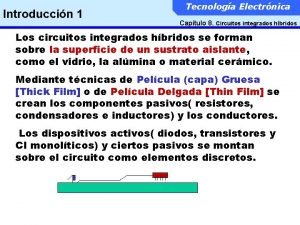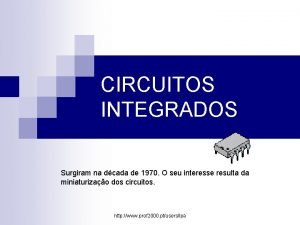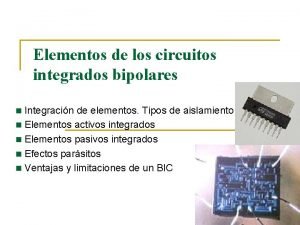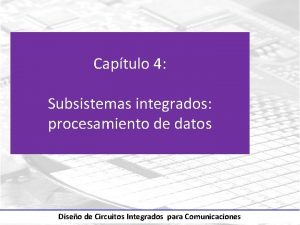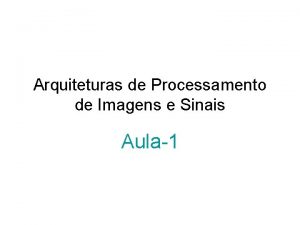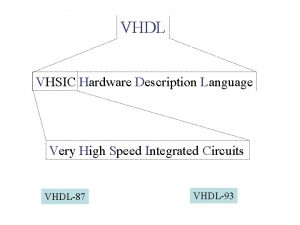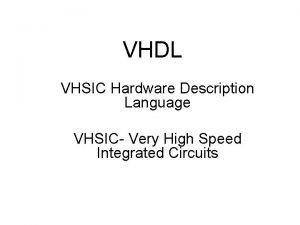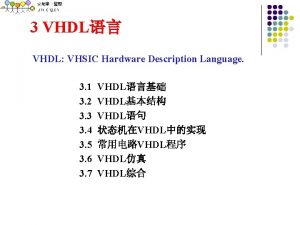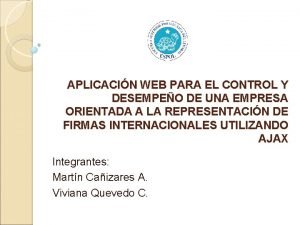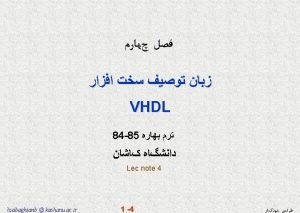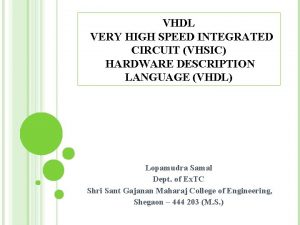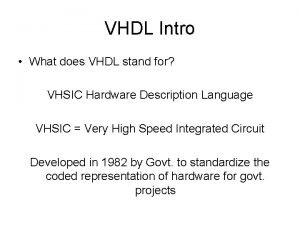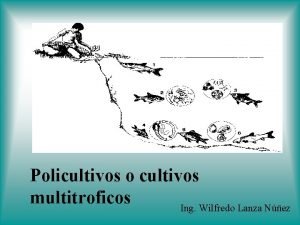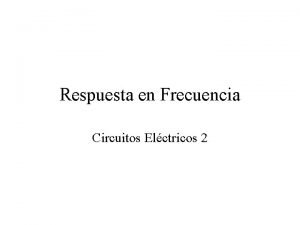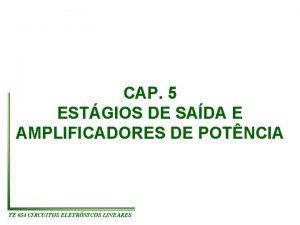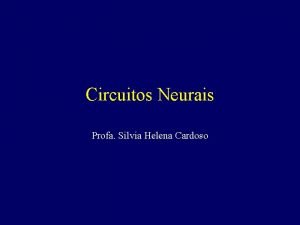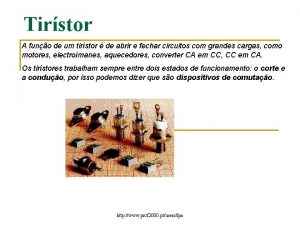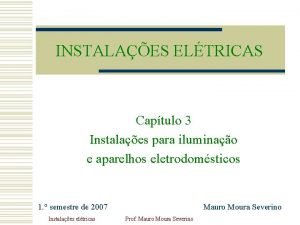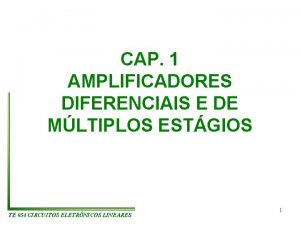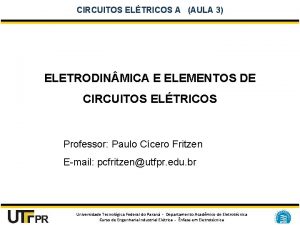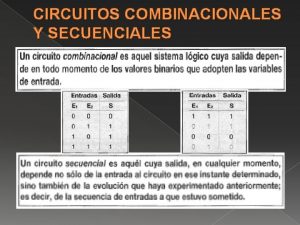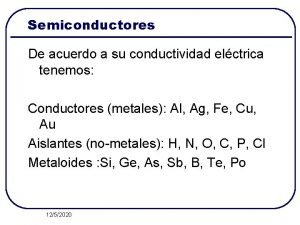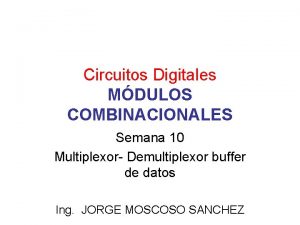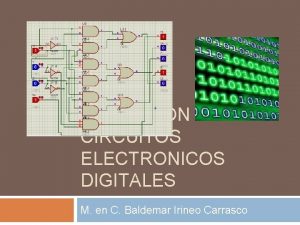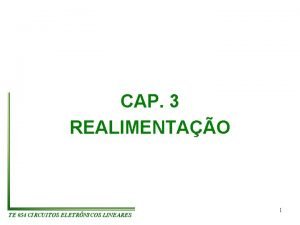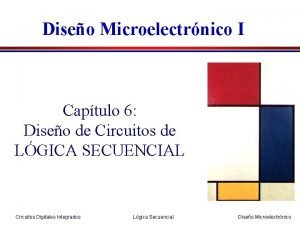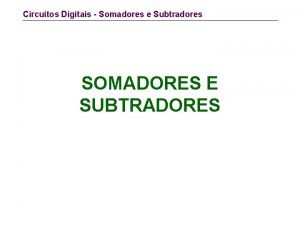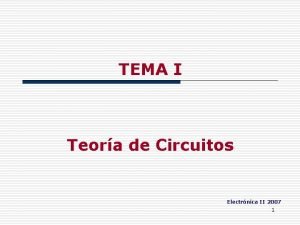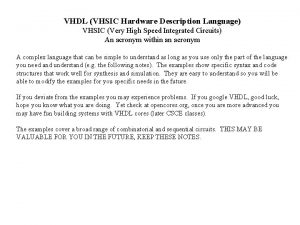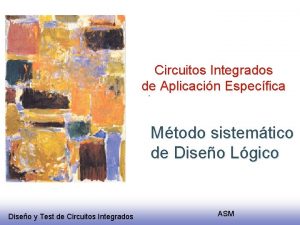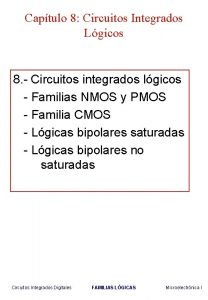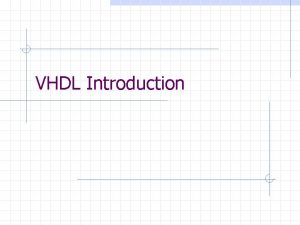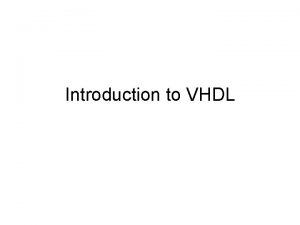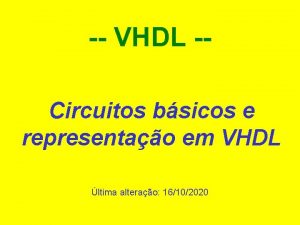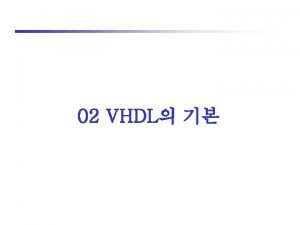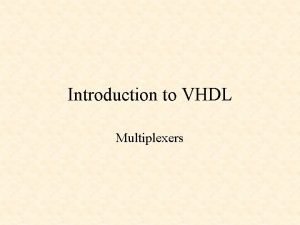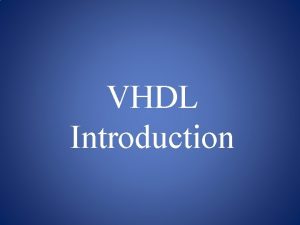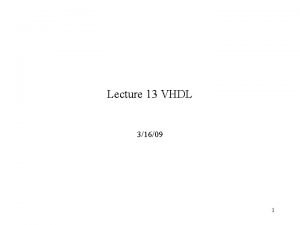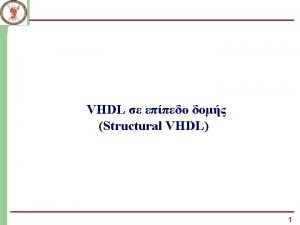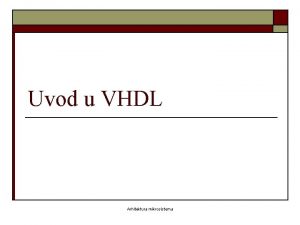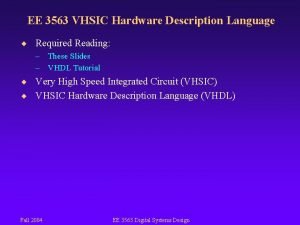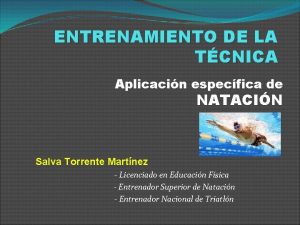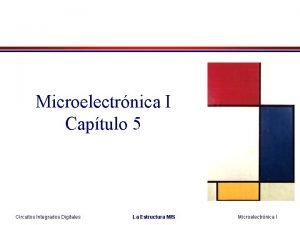Circuitos Integrados de Aplicacin Especfica VHDL VHSIC Hardware




![The process Statement [label: ] process [(sensitivity_list)] [declarations] begin {sequential_statement} end process [label]; q The process Statement [label: ] process [(sensitivity_list)] [declarations] begin {sequential_statement} end process [label]; q](https://slidetodoc.com/presentation_image_h2/bf46d3419c7ef24fd7c453f06e4b85a6/image-5.jpg)
![The wait Statement wait [on list_of_signals] [until boolean_expression] [for time_expression] ; q This is The wait Statement wait [on list_of_signals] [until boolean_expression] [for time_expression] ; q This is](https://slidetodoc.com/presentation_image_h2/bf46d3419c7ef24fd7c453f06e4b85a6/image-6.jpg)











































- Slides: 49

Circuitos Integrados de Aplicación Específica. VHDL: VHSIC Hardware Description Language Diseño de Circuitos de Aplicación Específica VHDL

A NAND Gate Example -- black-box definition (interface) entity NAND is generic ( Tpd : time : = 0 ns ); port ( A, B : in bit; Y : out bit ); end NAND; -- an implementation (contents) architecture BEHAVIOR_1 of NAND is begin Y <= A nand B after Tpd; end BEHAVIOR_1; Important Concepts entity architecture generic port waveform assignment Diseño de Circuitos de Aplicación Específica VHDL

Another Implementation of NAND -- there can be multiple implementations architecture BEHAVIOR_2 of NAND is signal X : bit; begin -- concurrent statements Y <= X after Tpd; X <= ‘ 1’ when A=’ 0’ or B=’ 0’ else ‘ 0’; end BEHAVIOR_2; Important Concepts multiple architectures signal concurrent statements Diseño de Circuitos de Aplicación Específica VHDL

Yet More NAND Gates! entity NAND_N is generic ( N : integer : = 4; Tpd : time); port ( A, B : in bit_vector(1 to N); Y : out bit_vector(1 to N)); end NAND_N; architecture BEHAVIOR_1 of NAND_N is begin process variable X : bit_vector(1 to N); begin X : = A nand B; Y <= X after Td; wait on A, B; end process; end BEHAVIOR_1; Diseño de Circuitos de Aplicación Específica Important Concepts process variable wait sequential statements events VHDL
![The process Statement label process sensitivitylist declarations begin sequentialstatement end process label q The process Statement [label: ] process [(sensitivity_list)] [declarations] begin {sequential_statement} end process [label]; q](https://slidetodoc.com/presentation_image_h2/bf46d3419c7ef24fd7c453f06e4b85a6/image-5.jpg)
The process Statement [label: ] process [(sensitivity_list)] [declarations] begin {sequential_statement} end process [label]; q It defines an independent sequential process which repeatedly executes its body q Following are equivalent: process (A, B) begin C <= A or B; end; q process begin C <= A or B; wait on A, B; end; No wait statements allowed in the body if there is a sensitivity_list Diseño de Circuitos de Aplicación Específica VHDL
![The wait Statement wait on listofsignals until booleanexpression for timeexpression q This is The wait Statement wait [on list_of_signals] [until boolean_expression] [for time_expression] ; q This is](https://slidetodoc.com/presentation_image_h2/bf46d3419c7ef24fd7c453f06e4b85a6/image-6.jpg)
The wait Statement wait [on list_of_signals] [until boolean_expression] [for time_expression] ; q This is the ONLY sequential statement during which time advances! q examples: -- wait for a rising or falling edge on CLK wait on CLK; wait until CLK’EVENT; -- this is equivalent to the above -- wait for rising edge of CLK wait on CLK until CLK=’ 1’; wait until CLK=’ 1’; -- this is equivalent to the above -- wait for 10 ns wait until 10 ns; -- wait for ever (the process effectively dies!) wait; Diseño de Circuitos de Aplicación Específica VHDL

A Simple Producer. Consumer Example DATA Produces REQ Consumer ACK Diseño de Circuitos de Aplicación Específica VHDL

Producer-Consumer in VHDL entity producer_consumer is end producer_comsumer; architecture two_phase of producer_consumer is signal REQ, ACK : bit; signal DATA : integer; begin P: process begin DATA <= produce(); REQ <= not REQ; wait on ACK; end P; C: process begin wait on REQ; consume(DATA); ACK <= not ACK; end C; end two_phase; Diseño de Circuitos de Aplicación Específica VHDL

VHDL 4 -Phase Case architecture four_phase of producer_consumer is signal REQ, ACK : bit : = ‘ 0’; signal DATA : integer; begin P: process begin DATA <= produce(); REQ <= ‘ 1’; wait until ACK=’ 1’; REQ <= ‘ 0’; wait until ACK=’ 0’; end P; C: process begin wait until REQ=’ 1’; consume(DATA); ACK <= ‘ 1’; wait until REQ=’ 0’; ACK <= ‘ 0’; end C; end four_phase; Diseño de Circuitos de Aplicación Específica VHDL

Muller C Element entity MULLER_C_ELEMENT is port (A, B : in bit; C : out bit); end MULLER_C_ELEMENT; A architecture BEHAVIOR is begin process begin B wait until A=’ 1’ and B=’ 1’; C <= ‘ 1’; wait until A=’ 0’ and B=’ 0’; C <= ‘ 0’; Could have written: end process; end BEHAVIOR; wait until A=B; C <= A; Diseño de Circuitos de Aplicación Específica VHDL C C

A Edge Triggered D Flip-Flop entity DFF is generic (T_setup, T_hold, T_delay : time: =0 ns); port (D, CLK: in bit; Q : out bit); begin -- check setup time assert not (CLK’EVENT and CLK=’ 1’ and D’LAST_EVENT < T_setup) report “Setup violation” severity WARNING; -- check hold time assert not (CLK’DELAYED(T_hold)’EVENT and CLK’DELAYED(Thold)=’ 1’ and D’LAST_EVENT < T_hold) report “Hold violation” severity WARNING; end DFF; Diseño de Circuitos de Aplicación Específica VHDL

A Edge Triggered D Flip. Flop (contd. ) architecture BEHAVIOR of DFF is begin process begin wait on CLK until CLK=’ 1’; Q <= D after T_delay; end process; end BEHAVIOR; Diseño de Circuitos de Aplicación Específica VHDL

Behavior vs. Structure Description q An entity can be described by its behavior or by its structure, or in a mixed fashion q Example: a 2 -input XOR gate Diseño de Circuitos de Aplicación Específica VHDL

XOR in VHDL: Behavior entity XOR is port ( A, B : in bit; Y : out bit); end XOR; architecture BEHAVIOR of XOR is begin Y <= (A and not B) or (not A and B); end BEHAVIOR; Diseño de Circuitos de Aplicación Específica VHDL

XOR in VHDL: Structure architecture STRUCTURE of XOR is component NAND port ( A, B : in bit; Y : out bit); end component; signal C, D, E : bit; begin G 1 : NAND port map (A, B, C); G 2 : NAND port map (A => A, B => C, Y => D); G 3 : NAND port map (C, B => B, Y => E); Component Instantiation G 4 : NAND port map (D, E, Y); is just another end STRUCTURE; Concurrent Statement! Diseño de Circuitos de Aplicación Específica VHDL

XOR in VHDL: Mixed architecture MIXED of XOR is component NAND port ( A, B : in bit; Y : out bit); end component; signal C, D, E : bit; begin D <= A nand C; E <= C nand B; G 1 : NAND port map (A, B, C); G 4 : NAND port map (D, E, Y); end MIXED; Diseño de Circuitos de Aplicación Específica VHDL

The Generate Statement q Used to generate iteratively or conditionally a set of concurrent statements. q Example: a ripple-carry adder entity RIPPLE_ADDER is port (A, B : in bit_vector; CIN : in bit; SUM : out bit_vector; COUT : out bit); begin assert A’LENGTH=B’LENGTH and A’LENGTH=SUM’LENGTH report “Bad port connections” severity ERROR; end; Diseño de Circuitos de Aplicación Específica VHDL

The Generate Statement (contd. ) architecture STRUCTURE of RIPPLE_ADDER is alias IN 1 : bit_vector(0 to A’LENGTH-1) is A; alias IN 2 : bit_vector(0 to A’LENGTH-1) is B; alias S : bit_vector(0 to A’LENGTH-1) is SUM; signal C : bit_vector(IN 1’RANGE); component FULL_ADDER port (A, B, CIN: in bit; S, COUT: out bit); end component; begin L 1: for I in S’RANGE generate L 2: if I=0 generate FA 1: FULL_ADDER port map (IN 1(0), IN 2(0), CIN, S(0), C(0)); end generate; L 3: if I>0 generate FA 2: FULL_ADDER port map (IN 1(I), IN 2(I), C(I-1), S(I), C(I)); end generate; COUT <= C(C’HIGH); end STRUCTURE; Diseño de Circuitos de Aplicación Específica VHDL

Concurrent vs. Sequential Statements q Concurrent Statements Process independent sequential process Block groups concurrent statements Concurrent Procedure convenient syntax for Concurrent Assertion commonly occurring form Concurrent Signal Assignment of processes Component Instantiation structure decomposition Generate Statement regular description Diseño de Circuitos de Aplicación Específica VHDL

Concurrent vs. Sequential Statements q Sequential Statements Wait synchronization of processes Assertion Signal Assignment Variable Assignment Procedure Call If Case Loop (for, while) Next Exit Return Null Diseño de Circuitos de Aplicación Específica VHDL

VHDL’s Model of a System Static network of concurrent processes communicating using signals q A process has drivers for certain signals q A signal may be driven by multiple processes q Diseño de Circuitos de Aplicación Específica VHDL

Similar to an OS q Reminds one of a multitasking OS! § And, most (all? ) VHDL simulators are indeed very similar in philosophy. . . a kernel process coordinates the activity of user-defined processes during simulation Diseño de Circuitos de Aplicación Específica VHDL

Anatomy of the VHDL Kernel vhdl_simulator_kernel() { /* initialization phase */ time = 0 ns; for (each process P) { run P until it suspends; } while TRUE do { /* this is one simulation cycle. . . */ if (no driver is active) { time = next time at which a driver is active or a process resumes; if (time = TIME’HIGH) break; } update_signals(); /* events may occur */ for (each process P) { if (P is sensitive to signal S & an event has occurred on S in this cycle) { resume P; /* put it on a list. . . */ } } for (each process P that has just resumed) { run P until it suspends; } } } Diseño de Circuitos de Aplicación Específica VHDL

Signals versus Variables architecture DUMMY_1 of JUNK is signal Y : bit : = ‘ 0’; begin process variable X : bit : = ‘ 0’; begin wait for 10 ns; X : = ‘ 1’; Y <= X; wait for 10 ns; -- What is Y at this point ? ‘ 1’. . . end process; end DUMMY_1; architecture DUMMY_2 of JUNK is signal X, Y : bit : = ‘ 0’; begin process begin wait for 10 ns; X <= ‘ 1’; Y <= X; wait for 10 ns; -- What is Y at this point ? ‘ 0’. . . end process; end DUMMY_2; Signal assignments with 0 delay take effect only after a delta delay. i. e. , in the next simulation cycle. Diseño de Circuitos de Aplicación Específica VHDL

Transaction Delay Models q VHDL has two distinct ways of modeling delays § Transport delay model signal <= transport waveform; l § for ideal devices with infinite frequency response in which every input pulse, however small, produces an output pulse Inertial delay model signal <= [reject time] inertial waveform; l l for devices with “inertia” so that not all pulses go through pulses < reject time are rejected Projected waveform Preemptive timing Transport delay Inertial delay Diseño de Circuitos de Aplicación Específica VHDL

Case 1: Transport Delay Model q Let: § Tnew = earliest transaction scheduled by a new signal assignment q Model: § All pending transactions at time Tnew are deleted § All new transactions are added Diseño de Circuitos de Aplicación Específica VHDL

Transport Delay Model (contd. ) Y <= 0 after 0 ns, 2 after 2 ns, 4 after 4 ns, 6 after 6 ns; wait for 1 ns; Y <= transport 3 after 2 ns, 5 after 4 ns, 7 after 6 ns; Diseño de Circuitos de Aplicación Específica VHDL

Case 2: Inertial Delay Model q Let: § Tnew = earliest transaction scheduled by a new signal assignment § Tr = pulse rejection limit q Model: § All pending transactions at time Tnew are deleted § All new transactions are added § Any pending transactions in the interval Tnew-Tr to Tnew are examined. If there is a run of consecutive transactions immediately preceding the earliest new transaction at Tnew with the same value as that new transaction, the yare kept. Other pending transactions in the interval are deleted. Diseño de Circuitos de Aplicación Específica VHDL

Inertial Delay Model (contd. ) Y <= 0 after 0 ns, 2 after 2 ns, 4 after 4 ns, 6 after 6 ns; wait for 1 ns; Y <= 3 after 2 ns, 5 after 4 ns, 7 after 6 ns; Diseño de Circuitos de Aplicación Específica VHDL

Inertial Delay Model (contd. ) -- suppose current time is 10 ns S <= reject 5 ns inertial ‘ 1’ after 8 ns; 11 ns 12 ns 14 ns 15 ns 16 ns 17 ns 20 ns 15 ns ‘ 1’ ‘X’ ‘ 1’ ‘ 0’ retained ‘ 1’ retained ‘ 0’ deleted pulse rejection interval (13 ns to 18 ns) 11 ns 12 ns 16 ns 17 ns 18 ns ‘ 1’ ‘X’ ‘ 1’ Diseño de Circuitos de Aplicación Específica new transaction ‘ 1’ VHDL

Signals with Multiple Drivers and, Y <= A; -- in process 1 Y <= B; -- in process 2 What is the value of the signal in such a case? q VHDL uses the concept of a Resolution Function that is attached to a signal or a type, and is called every time the value of signal needs to be determined -- that is every time a driver changes value Diseño de Circuitos de Aplicación Específica VHDL

Example: Wire-And (open collector) package RESOLVED is function wired_and (V: bit_vector) return bit; subtype rbit is wired_and bit; end RESOLVED; package body RESOLVED is function wired_and(V: bit_vector) return bit is begin for I in V’RANGE loop if V(I)= ‘ 0’ then return ‘ 0’; end if; end loop; return ‘ 1’; end wired_and; end RESOLVED; Diseño de Circuitos de Aplicación Específica VHDL

Guarded Signals: register & bus q Guarded signals are those whose drivers can be turned off q What happens when all drivers of a guarded signal are off? § Case 1: retain the last driven value – signal X : bit register; – useful for modeling charge storage nodes § Case 2: float to a user defined default value – signal Y : bit bus; – useful for modeling busses Diseño de Circuitos de Aplicación Específica VHDL

Guarded Signals (contd. ) q Two ways to turn off the drivers § null waveform in sequential signal assignment signal_name <= null after time_expression; § guarded concurrent signal assignment block (data_bus_enable=’ 1’) begin data_bus <= guarded “ 0011”; end block; Diseño de Circuitos de Aplicación Específica VHDL

Using VHDL Like C! q Normal sequential procedural programs can be written in VHDL without ever utilizing the event scheduler or the concurrent concepts. q Example: entity Hello. World is end; architecture C_LIKE of Hello. World is use std. textio. all; begin main: process variable buf : line; begin write(buf, ”Hello World!”); writeln(output, buf); wait; -- needed to terminate the program end process main; end C_LIKE; Diseño de Circuitos de Aplicación Específica VHDL

Language Features: Types TYPE = Set of Values + Set of Operations q VHDL types: SCALAR ENUMERATION e. g. character, bit, boolean INTEGER e. g. integer FLOATING e. g. real PHYSICAL e. g. time COMPOSITE ARRAY e. g. bit_vector, string RECORD ACCESS FILE q Diseño de Circuitos de Aplicación Específica VHDL

Examples of VHDL Types type bit is (‘ 0’, ‘ 1’); type thor_bit is (‘U‘, ‘ 0’, ‘ 1’, ‘Z’); type memory_address is range 0 to 2**32 -1; type small_float is range 0. 0 to 1. 0; type weight is range 0 to 1 E 8 units Gm; -- base unit Kg = 1000 Gm; -- kilogram Tonne = 1000 Kg; -- tonne end units; Diseño de Circuitos de Aplicación Específica VHDL

Language Features: Subtypes SUBTYPE = TYPE + constraints on values q TYPE is the base-type of SUBTYPE q SUBTYPE inherits all the operators of TYPE q SUBTYPE can be more or less used interchangeably with TYPE q Examples: subtype natural is integer range 0 to integer’HIGH; subtype good_thor_bit is thor_bit range ‘ 0’ to ‘ 1’; subtype small_float is real range 0. 0 to 1. 0; Diseño de Circuitos de Aplicación Específica VHDL

Array and Record Types -- unconstrained array (defines an array type) type bit_vector is array (natural range <>) of bit; -- constrained array (define an array type and subtype) type word is array (0 to 31) of bit; -- another unconstrained array type memory is array (natural range <>) of word; -- following is illegal! type memory is array (natural range <>) of bit_vector; -- an example record type PERSON is record name : string(1 to 20); age : integer range 0 to 150; end record; Diseño de Circuitos de Aplicación Específica VHDL

Language Features: Overloading Pre-defined operators (e. g. , +, -, and, nand etc. ) can be overloaded to call functions q Example: q function “and”(L, R : thor_bit) return thor_bit is begin if L=’ 0’ or R=’ 0’ then return ‘ 0’; elsif L=’ 1’ and R=’ 1’ then return ‘ 1’; else return ‘U’; end if; end “and”; -- now one can say C <= A and B; -- where A, B and C are of type thor_bit Diseño de Circuitos de Aplicación Específica VHDL

Overloading (contd. ) q Two subprograms (functions or procedures) can have the same name, i. e. , the names can be overloaded. They are distinguished by parameter types. e. g. , function MAX(A, B: integer) return integer; function MAX(A, B: real) return real; Diseño de Circuitos de Aplicación Específica VHDL

Language Features: Configurations q Component declarations really define a template for a design entity q The binding of an entity to this template is done through a configuration declaration entity data_path is. . . end data_path; architecture INCOMPLETE of data_path is component alu port(function : in alu_function; op 1, op 2 : in bit_vector_32; result : out bit_vector_32); end component; begin. . . end INCOMPLETE; Diseño de Circuitos de Aplicación Específica VHDL

Configurations (contd. ) … configuration DEMO_CONFIG of data_path is for INCOMPLETE for all: alu use entity work. alu_cell(BEHAVIOR) port map (function_code => function, operand 1 => op 1, operand 2 => op 2, result => result, flags => open); end for; end DEMO_CONFIG; Diseño de Circuitos de Aplicación Específica VHDL

Language Features: Packages q. A package is a collection of reusable declarations (constants, types, functions, procedures, signals etc. ) q. A package has a § declaration (interface), and a § body (contents) [optional] Diseño de Circuitos de Aplicación Específica VHDL

Example of a Package package SIMPLE_THOR is type thor_bit is (‘U’, ‘ 0’, ’ 1’, ’Z’); function “and”(L, R: thor_bit) return thor_bit; function “or”(L, R: thor_bit) return thor_bit; . . . end SIMPLE_THOR; package body SIMPLE_THOR is function “and”(L, R: thor_bit) return thor_bit is begin. . . end “and”; . . . end SIMPLE_THOR; -- and then it can be used after saying library my_lib; use my_lib. SIMPLE_THOR. all; Diseño de Circuitos de Aplicación Específica VHDL

Language Features: Design Units and Libraries q VHDL constructs are written in a design file and the compiler puts them into a design library. q Libraries are made up of design units § primary design units – entity declarations – package declarations – configuration declarations § secondary design units – architecture bodies – package bodies Diseño de Circuitos de Aplicación Específica VHDL

Design Units and Libraries (contd. ) q Libraries have a logical name and the OS maps the logical name to a physical name § for example, directories on UNIX q Two special libraries: § work: § std: q the working design library contains packages standard and textio To declare libraries that are referenced in a design unit: § library_name; q To make certain library units directly visible: § use library_name. unit_name; § use also defines dependency among design units. Diseño de Circuitos de Aplicación Específica VHDL

Logic Simulation in VHDL q The 2 -state bit data type is insufficient for lowlevel simulation q Multi-Valued types can easily be built in VHDL § several packages available § IEEE standard logic q Example: one may use a 4 -value (‘U’, ’ 0’, ’ 1’, ’Z’) system § but no notion of strength § only wired-X resolution q Multi-State/Strength systems with interval logic Diseño de Circuitos de Aplicación Específica VHDL

típico Código fuente VHDL Fichero objeto Analizador Linker Representación intermedia (IR) Compilador Código fuente en C Compilador C Binario ejecutable Debugger Elaboración Lenguaje de patrón PICL Patrón binario de entrada Diseño de Circuitos de Aplicación Específica Código fuente en C VÍDEO Ejecución Patrón binario de salida Pattern VHDL TEXTO
 Circuitos de computadora
Circuitos de computadora Imagenes de circuitos integrados de la tercera generacion
Imagenes de circuitos integrados de la tercera generacion Circuitos integrados
Circuitos integrados Circuito integrado multiplaca
Circuito integrado multiplaca Circuitos integrados
Circuitos integrados Fluiz
Fluiz Circuitos integrados
Circuitos integrados Circuitos integrados
Circuitos integrados Vhsic hardware description language
Vhsic hardware description language Vhsic hardware description language
Vhsic hardware description language Devider
Devider Especfica
Especfica Aplicacin
Aplicacin Hdl language
Hdl language Hdl is
Hdl is Vhsic
Vhsic Vhdl stands for
Vhdl stands for Internal and external hardware
Internal and external hardware Modelos integrados
Modelos integrados Sig@ufrpe
Sig@ufrpe Amg servicios integrados
Amg servicios integrados Tipos de sistemas integrados
Tipos de sistemas integrados Recursos integrados
Recursos integrados Diff serv
Diff serv Policultivo de peces
Policultivo de peces Red de servicios integrados
Red de servicios integrados 20,000
20,000 Circuitos de calidad
Circuitos de calidad Circuitos resistivos en paralelo
Circuitos resistivos en paralelo Circuitos eletrônicos
Circuitos eletrônicos Superposição circuitos
Superposição circuitos Circuito de papez
Circuito de papez Tirstor
Tirstor Ejercicios de circuitos combinacionales
Ejercicios de circuitos combinacionales Circuitos circulares
Circuitos circulares Distribuição de circuitos
Distribuição de circuitos Circuitos electricos 2 eso
Circuitos electricos 2 eso 1ricm
1ricm Circuitos eletricos
Circuitos eletricos Circuitos combinacionales y secuenciales
Circuitos combinacionales y secuenciales Circuitos logicos
Circuitos logicos Xor 3 entradas
Xor 3 entradas Circuitos msi
Circuitos msi Circuito de compras y pagos
Circuito de compras y pagos Circuitos logicos
Circuitos logicos I(0)
I(0) Realizacion
Realizacion Circuitos digitais
Circuitos digitais Metodo de mallas circuitos
Metodo de mallas circuitos Propiedades de la ley de ohm
Propiedades de la ley de ohm


